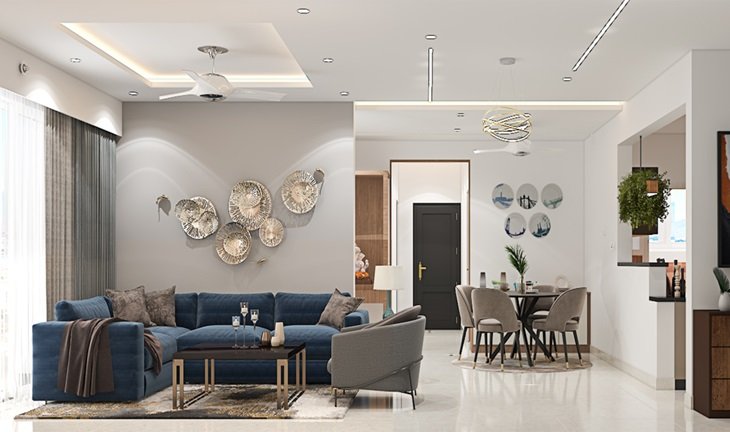
Minimalist Home
Introduction to Minimalism: Less is More
Minimalism is more than just a design trend; it’s a lifestyle choice focused on simplicity, functionality, and tranquility. At its core, minimalism is about removing excess items, embracing clean lines, and creating an environment that fosters calmness and clarity. A minimalist home isn’t just about having fewer possessions—it’s about choosing quality over quantity and creating a space that serves you, rather than overwhelms you.
This guide will provide actionable tips for decluttering your home and redesigning it with a minimalist aesthetic. Whether you’re looking to transform a single room or your entire living space, these strategies will help you achieve a clean, organized, and serene environment.
1. Start with a Clear Vision and Set Goals
Before you start decluttering and redesigning your home, it’s important to have a clear vision of what you want to achieve. Consider what minimalism means to you and how it aligns with your lifestyle. This could include:
- Reducing Stress: A minimalist home can reduce stress by eliminating visual clutter and creating a peaceful atmosphere.
- Creating More Space: Minimalism focuses on maximizing space by keeping only what is necessary.
- Enhancing Functionality: Every item in a minimalist home should serve a purpose, making the space more functional and efficient.
Set Clear Goals
- Identify Problem Areas: Start by identifying areas in your home that feel cluttered or overwhelming. Is it your living room, kitchen, or bedroom?
- Decide on a Theme: Decide on a minimalist theme that resonates with you—Scandinavian, Japanese, or modern minimalism, for example.
- Set Realistic Milestones: Set small, achievable milestones for decluttering and redesigning each room. This could be as simple as clearing out a single drawer or redesigning a whole room.
2. Declutter: The First Step Towards Minimalism
Decluttering is the foundation of a minimalist home. It involves carefully evaluating each item you own and deciding whether it serves a purpose or adds value to your life.
Steps to Effective Decluttering
- The KonMari Method: Popularized by Marie Kondo, this method involves holding each item and asking yourself if it “sparks joy.” If not, it’s time to let it go.
- The Four-Box Method: Set up four boxes labeled “Keep,” “Donate,” “Sell,” and “Trash.” As you go through each room, sort items into these boxes to simplify the decluttering process.
- One Room at a Time: Focus on decluttering one room at a time. Start with less emotionally charged spaces like the bathroom or kitchen before moving on to bedrooms or living areas.
- Digitize Where Possible: Reduce paper clutter by digitizing documents, photos, and other paper items. Store them securely on a cloud service or an external hard drive.
Tips for Letting Go of Sentimental Items
- Keep the Memories, Not the Objects: Consider taking photos of sentimental items before parting with them.
- Limit Keepsakes: Choose a few special items that hold the most meaning and display them thoughtfully, rather than keeping everything.
3. Redesign Your Space: Embrace Simplicity and Functionality
Once you’ve decluttered, it’s time to redesign your space to reflect minimalist principles. The goal is to create a clean, cohesive, and serene environment that promotes relaxation and clarity.
Design Principles for a Minimalist Home
- Neutral Color Palette: Opt for a neutral color palette—think whites, grays, beiges, and soft earth tones. These colors create a calm and airy atmosphere that is key to minimalism.
- Simple Furniture: Choose furniture with clean lines and simple designs. Pieces should be functional, comfortable, and aesthetically pleasing.
- Use Natural Materials: Incorporate natural materials like wood, linen, and cotton to add warmth and texture to your minimalist space.
- Open Space Layouts: Embrace open space layouts that allow for free movement and a sense of openness. Avoid cluttering rooms with too much furniture.
Maximize Natural Light
- Remove Heavy Curtains: Opt for light, sheer curtains or blinds that allow natural light to flow into your home. Natural light enhances the minimalist aesthetic and makes spaces feel more open and airy.
- Use Mirrors Strategically: Placing mirrors opposite windows can reflect natural light and make rooms appear larger and brighter.
4. Organize and Optimize Storage Solutions
In a minimalist home, every item should have its designated place. Organizing your belongings and optimizing storage solutions is essential to maintaining a clutter-free environment.
Creative Storage Solutions for Minimalism
- Hidden Storage: Use furniture with built-in storage, such as ottomans, benches, and coffee tables with compartments.
- Floating Shelves: Install floating shelves to display essential items while keeping the floor space clear.
- Under-Bed Storage: Utilize the space under your bed for storage bins or drawers to keep seasonal clothing, shoes, or extra linens.
- Vertical Space: Make the most of vertical space by installing tall shelves or cabinets that go up to the ceiling.
Organizing Tips to Keep Clutter at Bay
- Label Storage Containers: Labeling storage containers can help you easily locate items and keep things organized.
- Regularly Reassess Belongings: Minimalism is an ongoing process. Regularly reassess your belongings to ensure they still serve a purpose or bring joy.
- Adopt a “One In, One Out” Rule: For every new item you bring into your home, consider removing an old one. This helps prevent clutter from building up again.
5. Create Functional and Minimalist Living Spaces
A minimalist home is more than just a visual aesthetic; it’s about creating functional and intentional living spaces. Each room should serve its purpose and offer a sense of peace.
Living Room Minimalism
- Choose a Focal Point: Select a focal point, such as a piece of art or a minimalist coffee table, and arrange your furniture around it. Avoid overcrowding the space.
- Keep Decorations Minimal: Limit decorations to a few carefully chosen pieces that add personality without overwhelming the room.
- Use Plants for Freshness: Incorporate a few well-placed indoor plants to bring life and color to your space without adding clutter.
Minimalist Bedroom Design
- Opt for a Simple Bed Frame: Choose a low-profile bed frame with clean lines. Avoid overly ornate designs that can make the room feel crowded.
- Keep Nightstands Clear: Limit what you keep on your nightstand to essentials like a lamp, a book, or an alarm clock.
- Store Seasonal Clothing: Rotate clothing seasonally and store out-of-season items to keep your closet clean and organized.
Minimalist Kitchen Essentials
- Clear Countertops: Keep countertops clear of unnecessary gadgets and appliances. Store them away when not in use to maintain a clean and clutter-free appearance.
- Invest in Quality Cookware: Opt for high-quality, multipurpose cookware that reduces the need for excessive kitchen tools.
- Organize the Pantry: Use clear containers to store pantry items, making it easy to see what you have and reducing the need for packaging clutter.
6. Maintain Your Minimalist Home: Daily Habits for a Clutter-Free Life
Achieving a minimalist home is one thing; maintaining it is another. Developing daily habits can help keep your home clutter-free and aligned with minimalist principles.
Daily Habits to Maintain Minimalism
- Clean as You Go: Instead of allowing clutter to build up, clean and tidy as you go about your daily routine. This could mean putting away dishes immediately after meals or folding laundry as soon as it’s done.
- Practice Mindful Shopping: Avoid impulse purchases and carefully consider new items before bringing them into your home. Ask yourself if the item serves a purpose or brings joy.
- Schedule Regular Decluttering Sessions: Set aside time every few months to go through your belongings and declutter. This helps keep your home organized and prevents clutter from accumulating.
7. Minimalism Beyond the Home: Adopting a Minimalist Lifestyle
Creating a minimalist home often leads to embracing minimalism in other areas of life, such as digital spaces, personal schedules, and finances.
Digital Minimalism
- Declutter Your Digital Space: Organize your digital files, unsubscribe from unnecessary email lists, and remove apps that no longer serve you.
- Limit Screen Time: Embrace digital minimalism by setting boundaries for screen time and focusing on more meaningful activities.
Simplify Your Schedule
- Prioritize Your Time: Focus on activities and commitments that align with your values and goals. Learn to say no to unnecessary engagements that add stress.
- Embrace Slow Living: Slow down and savor the small moments in life. This can lead to a more fulfilling and less hectic lifestyle.
Conclusion: Embrace Minimalism for a Calmer, More Intentional Home
Creating a minimalist home is a journey that requires patience, mindfulness, and a commitment to simplicity. By decluttering your space, redesigning with intention, and adopting minimalist habits, you can create a home that is not only visually appealing but also deeply functional and peaceful. Minimalism encourages you to live with purpose, focus on what truly matters, and cultivate an environment that supports your well-being.




